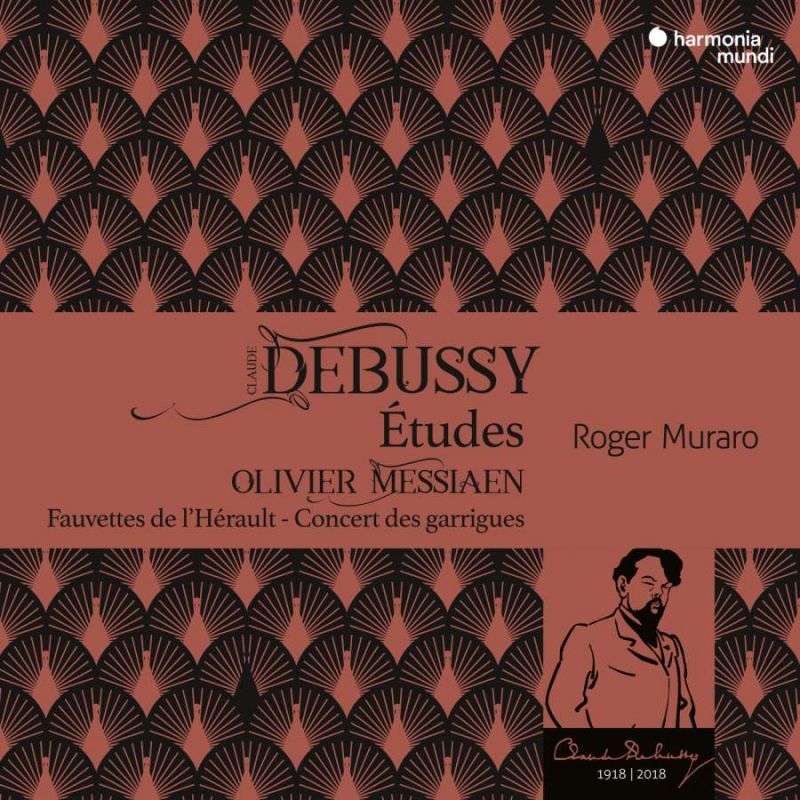DEBUSSY Études MESSIAEN Fauvettes de l’Hérault (Roger Muraro)
View record and artist detailsRecord and Artist Details
Composer or Director: Claude Debussy, Olivier Messiaen
Genre:
Instrumental
Label: Harmonia Mundi
Magazine Review Date: 01/2019
Media Format: CD or Download
Media Runtime: 73
Mastering:
DDD
Catalogue Number: HMM90 5304

Tracks:
| Composition | Artist Credit |
|---|---|
| (12) Etudes |
Claude Debussy, Composer
Claude Debussy, Composer Roger Muraro, Piano |
| Fauvettes de l’Hérault |
Olivier Messiaen, Composer
Olivier Messiaen, Composer Roger Muraro, Piano |
Author: Jed Distler
Perianes unleashes No 7’s turbulent waves of arpeggios with little help from the sustain pedal, while precisely scaling the dynamics and accents so as not to overbuild: an unorthodox approach, to be sure, yet ultimately convincing. No 8’s flaxen-haired girl makes an understated impact, while No 9’s repeated notes descend with supple lilt and lightness of being. While more intense and divergently balanced versions of ‘La cathédrale engloutie’ exist, Perianes’s reading is shapely and impeccably paced. For all the control of ‘La danse de Puck’, Perianes underplays its harmonic surprises; but his slightly arch teasing of the melodic line brings out the quirky cakewalking character in ‘Minstrels’.
In Estampes, Perianes generally goes for allure and suggestion, sometimes to the music’s disadvantage, His soft-grained blending of left-hand chords against right-hand runs in the section of ‘Pagodes’ marked sans lenteur is opposed to Debussy’s dans une sonorité plus claire request. By contrast, Sviatoslav Richter brings this passage’s gamelan-inspired polyphony into far bolder relief. And compared to the lithe animation of Jean-Efflam Bavouzet in ‘Jardins sous la pluie’, Perianes runs on cruise control, so to speak. But his curvaceous ‘La soirée dans Grenade’ is right on target, and what impressive independence between the hands.
For the most part, Roger Muraro’s attention to detail puts a fresh spin on Debussy’s Études. He takes No 1’s introductory Czerny-scale pastiche briskly and brusquely, while characterising the main section’s sudden rubato measures as abrupt interruptions. He keeps No 2’s legato thirds resolutely yet flexibly moderato, while distinctions between sustained and detached articulation in No 3 have rarely been so well articulated. Also notice how Muraro reins in the repeated sixths in No 4’s poco agitato sequences so that they don’t get too loud too soon.
In the waltzing lilt of No 5, some may prefer a tighter leash on the basic pulse, but Muraro’s full-bodied staccato playing grabs your ear. Despite Uchida’s élan and surface sheen in No 6, Muraro’s slower tempo gives Debussy’s dynamic hairpins and articulation markings their due. Inspiration sags in No 7, leaving Uchida and Bavouzet to capture the étude’s scherzando sparkle. Muraro’s similarly low-key No 8, however, allows the composer’s rich harmonies and resonant overtones to truly sink in, although his repeated notes in No 9 don’t match his aforementioned colleagues’ incisiveness. Muraro’s mature mastery reveals itself throughout No 10, particularly in the sustained calm of the cross-handed chord sequence starting at bar 15 and the careful gauging of the Sempre animando’s climax. He builds No 11 from the bottom up, bringing bass lines and melodic up beats to the fore. The pianist also takes the diminuendo and staccato markings of No 12’s octave leaps seriously and uncovers hidden melodies few others notice.
The three-movement Messiaen work represents Muraro’s 2017 solo piano reconstruction of what was originally planned as a concerto. A looming deadline compelled Messaien to scale down the project and rework his ideas for what would become the Sept Haïkaï for piano and small ensemble. Most of the material is based on birdsong that Messiaen notated during a 1958 visit to the Hérault region of southern France. Not surprisingly, the music’s florid asymmetry, rapid chordal flights and rapid-fire contrasts between lyrical repose and fiery virtuosity relate to the sound world and time-scale presented in Catalogue d’oiseaux. Muraro’s assured and fervent immersion in Messiaen’s idiom is not a surprise, given his long and distinctive history with the composer’s keyboard output in concert and on disc.
In sum, both CDs offer much stimulating listening, reservations notwithstanding.
Discover the world's largest classical music catalogue with Presto Music.

Gramophone Digital Club
- Digital Edition
- Digital Archive
- Reviews Database
- Full website access
From £8.75 / month
Subscribe
Gramophone Full Club
- Print Edition
- Digital Edition
- Digital Archive
- Reviews Database
- Full website access
From £11.00 / month
Subscribe
If you are a library, university or other organisation that would be interested in an institutional subscription to Gramophone please click here for further information.




